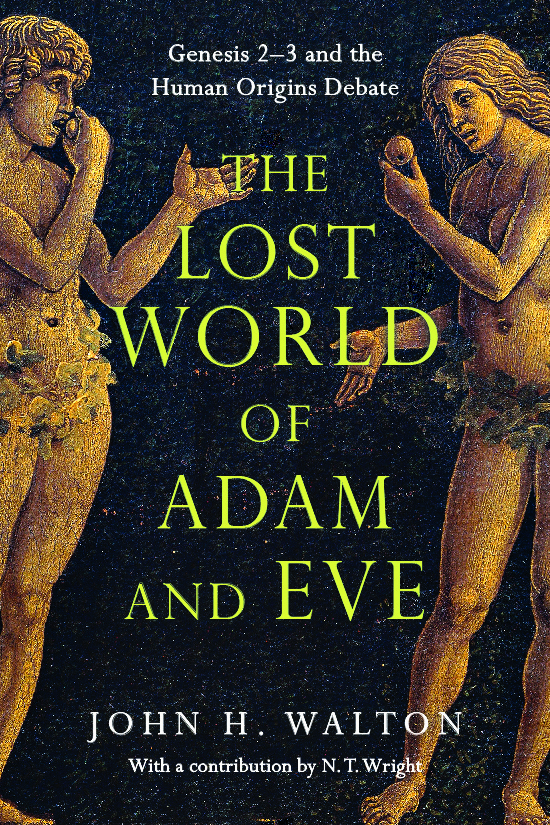 John Walton‘s book The Lost World of Adam and Eve (InterVarsity Press, 2015) is a fresh, compelling look at Genesis 2-3. In it, Walton argues that the role of Adam and Eve is mainly archetypal, symbolic of humanity as a whole. But he also argues that they are historical figures and responsible for the Fall, simply not the first human beings.
John Walton‘s book The Lost World of Adam and Eve (InterVarsity Press, 2015) is a fresh, compelling look at Genesis 2-3. In it, Walton argues that the role of Adam and Eve is mainly archetypal, symbolic of humanity as a whole. But he also argues that they are historical figures and responsible for the Fall, simply not the first human beings.
Walton marshals an impressive array of Hebrew expertise and familiarity with Ancient Near Eastern texts to make his case. For example, he compares human origin stories of the Ancient Near East to Genesis, arguing that Genesis, as well as the other stories are archetypal in their usage. When Genesis 2 says that Adam was formed from “dust,” Walton argues that this is not a statement about the material from which Adam was formed, but a symbolic statement that all of humanity is mortal, as Psalm 103 states. Walton also argues that Eve was not formed from a literal “rib,” of Adam, but that Adam had a vision in which half of him was used to form Eve, his equal and partner. These are things that the original Hebrew audience would have understood, hearing the accounts for the first time.
As well, Walton argues that Genesis 2 is not a more detailed description of Day 6 from Genesis 1, as is often assumed, but is rather a “sequel,” a further creation account that occurred after the creation of humanity in Day 6. Thus, the formation of Adam and Eve here is not describing the beginning of humanity, but the election of Adam & Eve to be priests to tend the Garden as sacred space.
In making his case, Walton takes a detailed look at the Hebrew usage of the relevant texts. For example, he surveys the use of the Hebrew word adam in Genesis and the remainder of the Old Testament, and suggests an archetypal usage, as adam often is generic for “man.” He argues that the Hebrew word toledot (“this is the account of”) in Genesis 2:4 points toward a “sequel” interpretation of Genesis 2, rather than a more detailed account of Day 6.
Walton then goes on to make a case that, for Christian theology, it is not important that Adam & Eve were the first human beings, only that they were responsible for the Fall. He takes a detailed look at Romans 5, and concludes that Paul is sometimes teaching an archetypal view of Adam there, and sometimes referring to a literal Adam. When Paul refers to Adam as “the first man,” he is speaking symbolically, just as when he calls Jesus “the second man” or “the last Adam,” he is speaking symbolically, and not literally saying Jesus was the last human being (or the second one). Part of Walton’s motivation here is the latest genetic research that indicates humans are not descended from one couple, but a small population of 8,000-10,000 people. But he makes it clear that his case is based on the actual OT and NT texts and comparison with other texts from the Ancient Near East, not simply special pleading because of the genetic evidence.
Walton also makes an interesting case that although we experience death through Adam’s sin, Adam was not immortal when God created him. He believes that, because God gave Adam & Eve access to the tree of life, this indicates they were created mortal, as they would not have needed the tree of life if they were immortal. On this view, when Paul states in Romans 5:12 that “death came through sin, and in this way death came to all because all sinned,” he is not stating that Adam was in an immortal state before he sinned, only that we face death today because we have no access to the tree of life. Because of Adam’s sin, we were banished from the tree forever. This, it seems to me, is a plausible explanation.
Not all will be convinced by Walton’s arguments, and some of his interpretations of other New Testament passages seem weaker than his Old Testament treatments. For example, the traditional view of Acts 7:26, “From one man He made every nation of men,” is that Paul is speaking of Adam here. Walton argues from Genesis 10 that the use of “nations” here means that the “one man” is referring to Noah. This of course, is one possible interpretation of this passage, but is it the most probable one? It will be interesting to see how NT theologians respond to Walton’s arguments.
Nevertheless, Walton makes a compelling case in his book overall. From here on, Old Testament scholars who write on Genesis 2-3 will need to interact with Walton’s formidable original thinking.
Mark is on staff with InterVarsity Christian Fellowship in Manhattan, Kansas, where he ministers to Faculty at Kansas State University and surrounding campuses. He has been in campus ministry 25 years, 14 of those years in faculty ministry. He has a Master’s degree in philosophy and theology from Talbot School of Theology, La Mirada, CA, and is passionate about Jesus Christ and the life of the mind. Mark, his wife and three daughters make their home in Manhattan.

Leave a Reply